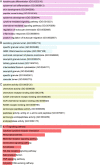Network analysis of potential risk genes for psoriasis
- PMID: 34134787
- PMCID: PMC8210373
- DOI: 10.1186/s41065-021-00186-w
Network analysis of potential risk genes for psoriasis
Abstract
Background: Psoriasis is a complex chronic inflammatory skin disease. The aim of this study was to analyze potential risk genes and molecular mechanisms associated with psoriasis.
Methods: GSE54456, GSE114286, and GSE121212 were collected from gene expression omnibus (GEO) database. Differentially expressed genes (DEGs) between psoriasis and controls were screened respectively in three datasets and common DEGs were obtained. The biological role of common DEGs were identified by enrichment analysis. Hub genes were identified using protein-protein interaction (PPI) networks and their risk for psoriasis was evaluated through logistic regression analysis. Moreover, differentially methylated positions (DMPs) between psoriasis and controls were obtained in the GSE115797 dataset. Methylation markers were identified after comparison with the common genes.
Results: A total of 118 common DEGs were identified, which were mainly involved in keratinocyte differentiation and IL-17 signaling pathway. Through PPI network, we identified top 10 degrees as hub genes. Among them, high expression of CXCL9 and SPRR1B may be risk factors for psoriasis. In addition, we selected 10 methylation-modified genes with the higher area under receiver operating characteristic curve (AUC) value as methylation markers. Nomogram showed that TGM6 and S100A9 may be associated with an increased risk of psoriasis.
Conclusion: This suggests that immune and inflammatory responses are active in keratinocytes of psoriatic skin. CXCL9, SPRR1B, TGM6 and S100A9 may be potential targets for the diagnosis and treatment of psoriasis.
Keywords: Differentially expressed genes; Differentially methylated positions; Pathogenesis; Psoriasis.
Conflict of interest statement
The authors declare no competing interests.
Figures




Similar articles
-
Prediction of crucial epigenetically‑associated, differentially expressed genes by integrated bioinformatics analysis and the identification of S100A9 as a novel biomarker in psoriasis.Int J Mol Med. 2020 Jan;45(1):93-102. doi: 10.3892/ijmm.2019.4392. Epub 2019 Oct 31. Int J Mol Med. 2020. PMID: 31746348 Free PMC article.
-
Decoding Psoriasis: Integrated Bioinformatics Approach to Understand Hub Genes and Involved Pathways.Curr Pharm Des. 2020;26(29):3619-3630. doi: 10.2174/1381612826666200311130133. Curr Pharm Des. 2020. PMID: 32160841
-
Identification of candidate biomarkers and pathways associated with psoriasis using bioinformatics analysis.Hereditas. 2020 Jul 15;157(1):30. doi: 10.1186/s41065-020-00141-1. Hereditas. 2020. PMID: 32669126 Free PMC article.
-
Screening of Skin Lesion-Associated Genes in Patients with Psoriasis by Meta-Integration Analysis.Dermatology. 2017;233(4):277-288. doi: 10.1159/000481619. Epub 2017 Nov 15. Dermatology. 2017. PMID: 29136636 Review.
-
Is there a relationship between psoriasis and hepatitis C? A meta-analysis and bioinformatics investigation.Virol J. 2021 Jul 2;18(1):135. doi: 10.1186/s12985-021-01606-z. Virol J. 2021. PMID: 34215260 Free PMC article.
Cited by
-
Screening of key genes related to autophagy in psoriasis based on gene expression profiling.Postepy Dermatol Alergol. 2024 Dec;41(6):577-583. doi: 10.5114/ada.2024.145618. Epub 2024 Dec 18. Postepy Dermatol Alergol. 2024. PMID: 39877103 Free PMC article.
-
Identification and mechanistic insights of cell senescence-related genes in psoriasis.PeerJ. 2025 Jan 14;13:e18818. doi: 10.7717/peerj.18818. eCollection 2025. PeerJ. 2025. PMID: 39830966 Free PMC article.
-
Identification of potential key molecules and signaling pathways for psoriasis based on weighted gene co-expression network analysis.World J Clin Cases. 2022 Jun 26;10(18):5965-5983. doi: 10.12998/wjcc.v10.i18.5965. World J Clin Cases. 2022. PMID: 35949853 Free PMC article.
References
MeSH terms
Grants and funding
LinkOut - more resources
Full Text Sources
Medical
Research Materials
Miscellaneous

